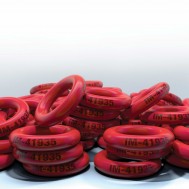Rubber o-rings are a common sealing device that hold a lot of responsibility. From automotive and hydraulics to aerospace and medical, o-rings serve as trusted sealing solutions for a variety of industries.
While these rubber devices play a crucial role in many important applications, they are not immune to failure. O-Rings can fail for many different reasons, but it’s usually caused by a combination of adverse effects and environmental factors. While unexpected failure can cause catastrophic damages to other parts and applications, there are preventative measures to be taken to lessen the chance of o-ring failure down the line. Here are the most common causes of o-ring failure and how to solve them.
Compression Set
Every o-ring seal has a specific amount of squeeze, or compression, that it can undergo before excessive deformation occurs. When an o-ring is exposed to high temperatures, swell, overly high compression or other major stresses, it can lose its elasticity and become unable to return to its original shape. This will cause the o-ring to develop flat surfaces on both sides of the cross-section, making it unable to properly seal.
Solution: Select an elastomer with a low compression set and reduce o-ring squeeze when possible. It’s also important to assure that the sealing material is compatible with the temperatures it’s exposed to and any other environmental conditions that may impact the sealing capabilities.
Abrasion
Abrasion is a common cause of o-ring failure that is typically seen in dynamic seals. When excessive friction between an o-ring and another surface is present, the o-ring will begin to wear down until eventually tearing. It’s common for metal surfaces to be too rough and act as an abrasive. Conversely, metal surfaces can also be too smooth, which leads to inadequate lubrication.
Lubrication plays a big role in sealing success. Lack of lubrication in the presence of friction can also lead to seal failure.
Solution: Always make sure there is enough lubrication present during any sealing application. During the o-ring design process, material selection is extremely important. Materials should be durable enough to handle any natural friction or the presence of abrasive materials in their application.
Chemical Swell
O-Rings act as a sponge that absorbs the surrounding fluid. However, when a sealing material is not compatible with the chemicals it absorbs or can’t handle the amount of humidity present, o-rings will begin to excessively swell. Chemical swell can lead to the loss of physical properties such as tensile, gland fill, extrusion and the complete loss of sealing strength.
Solution: During the material selection process, make sure that your sealing material is compatible with the chemicals it will be in contact with. Visit Apple Rubber’s Chemical Compatibility Guide to map out what each sealing material is compatible with.
Want to talk more about o-ring failure?
Tweet us @AppleRubber to continue the conversation.
